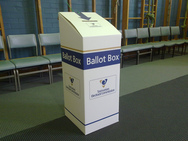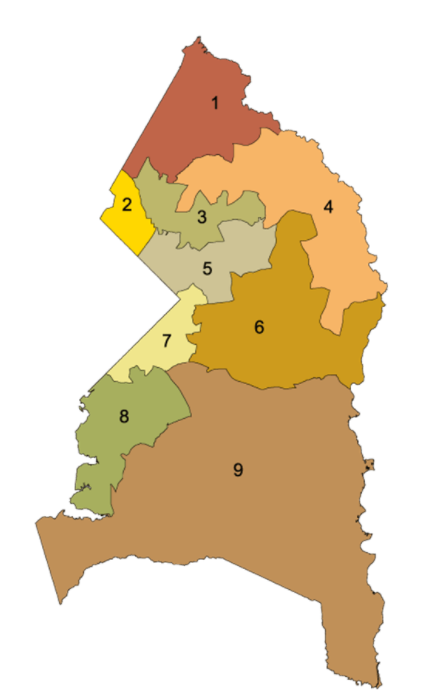How would at-large seats change the Prince George’s County Council?
Prince George’s voters will decide whether to create two new at-large county council seats in the November 8 election. If the measure (Question D) passes, it will mean more councilmembers who have the entire county’s interest in mind.
Currently, the Prince George’s legislative branch is made up of nine council districts of roughly equal population. Each district is represented by one council member, and residents can only vote in the race in that district. The county executive is elected at large by residents throughout the county.
Question D would change the makeup of the council. In addition to the nine council districts, there will be two at-large seats, and all county residents will be able to vote for those at-large members, like they do for county executive now.
Parochialism and sprawl go hand in hand
Matt wrote about why Prince George’s would benefit from at-large council seats in 2013, after he went to testify on an issue in Upper Marlboro (the current county seat, pending a possible move to Largo) and found the only council member paying attention was his. In his case, as with many others, the other eight council members had no need to pay attention or fear retribution. After all, only their district’s residents can vote for or against them.
A district-based focus is particularly a problem when it comes to establishing priorities at the county level. For example, every council member wants development in their district, but the result of that is sprawl.
Without at-large members, the council can have difficulty thinking of the good for the county versus only the good for their districts. So instead of focusing development around Metro stations and existing communities, some council members push for more development in their districts even though they may be far flung from existing infrastructure.
At-large members, on the other hand, would be responsible to county residents as a whole, which incentivizes them to think of the county rather than just their district. It won’t necessarily mean that the needs of any one district won’t sometimes prevail over the needs of the county as a whole, but at-large members will help to shift the debate.
Term limits and cost add controversy
The current proposal before Prince George’s County voters calls for the creation of two new at-large seats. In addition, district members will be eligible to run for the at-large seats, even though Prince George’s County has a two-term limit for council members.
This proposal means that, hypothetically, a district council member could serve two terms and then get two more terms as an at-large member. The Washington Post therefore mocked the measure as “a jobs plan for Prince George’s County council members.”
This initiative would have had an easier political road if it didn’t mean a budget increase for the council to cover new salaries, staff, and discretionary budgets, or effectively lengthen existing eight-year term limits, which the county’s voters recently narrowly affirmed.As it stands, for those who are passionate about term limits, this proposal is a Trojan horse that allows politicians to stay in office longer than the spirit or the letter of the current charter allows.
On the other hand, for those who don’t think term limits are a good idea (which in 2014 was 49% of Prince George’s County voters), this part of the proposal is a benefit. Creating a small path for career advancement for legislators through the at-large system actually could be a good way to ensure the best members can keep serving the public, they argue. Oddly, the Post editorial board recommend against term limits for Montgomery County while criticizing the Prince George’s proposal for weakening them.
Creating at-large seats could have equity impacts as well
The county’s charter provides for the council districts to be drawn on the basis of population after each census, to contain roughly equal population. That’s why the districts bordering the District of Columbia are relatively small and and they’re much larger farther out.
Voter registration, however, is not nearly so evenly distributed:
| District | Registered
voters (2012) |
2010 pop. | % registered | Avg. median household income by census block | % 19 & younger |
| 1 | 60,604 | 98,363 | 62% | $101,163 | 26% |
| 2 | 36,509 | 91,928 | 40% | $77,886 | 25% |
| 3 | 53,757 | 99,038 | 54% | $85,456 | 30% |
| 4 | 63,001 | 98,724 | 64% | $115,629 | 26% |
| 5 | 60,613 | 94,362 | 64% | $85,060 | 29% |
| 6 | 83,556 | 96,932 | 86% | $119,816 | 28% |
| 7 | 61,910 | 94,794 | 65% | $74,968 | 28% |
| 8 | 68,898 | 93,892 | 73% | $87,953 | 25% |
| 9 | 79,743 | 94,804 | 84% | $102,180 | 27% |
| Total | 568,591 | 862,837 | 66% | did not calculate | 27% |
In District 2, where Tracy serves on the Mount Rainier city council, only 40% of the population is registered to vote. There are a lot of demographic reasons for this: there are more immigrants and lower incomes in this part of the county, both of which tend to make it harder to both register to vote and to actually get out and vote.
In districts 6 and 9, on the other hand, the vast majority of the population is registered to vote. That means at-large candidates building from these bases will have an advantage when running. It also means places with more poor people and immigrants have less of a voice in choosing those representatives.
The county needs voter registration, education, and turnout efforts in order to actually fulfill the hoped-for potential of the at-large seats. Otherwise, the densest and most urban parts of the county will continue to be under-represented.
At-large seats likely mean more accountability to voters
The legacy of this decision extends far beyond the next one or two elections. Over the long term, demographics in the county will continue to shift, voter registration efforts can pay off, and the basic political theory undergirding at-large seats (that those holding them have an incentive to think regionally) will still apply. The people sitting in the at-large seats will be accountable to more voters.
If Prince George’s is going to be competitive in the region and attentive to the needs of all of its residents, it’s important that someone at the legislative level is thinking about the good of the county as a whole, and not simply one district.


